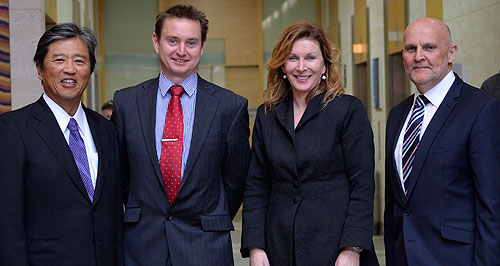Make / Model Search
News - ToyotaToyota teams with hospital to improve efficiencyHelping hands: From left, Toyota Australia chairman Max Yasuda, St Vincent’s Hospital CEO Ben Fielding, St Vincent’s Australian Divisional CEO Patricia O’Rourke and Toyota Australia president Dave Buttner. Queue forms after Toyota helps heal Melbourne hospital’s pill-packaging process1 Aug 2014 By IAN PORTER UPDATED: 07/08/2014TOYOTA Australia is demonstrating one of the unexpected flow-on benefits of having an indigenous car manufacturing industry by helping a Melbourne hospital achieve remarkable efficiency gains. The Japanese automotive giant’s move into healthcare comes after decades of leadership in manufacturing, where the company has been instrumental in propagating its continuous improvement ethos. Toyota has helped transform the way in which the St Vincent’s Hospital packaged medications for its patients, slashing the cycle time by more than 80 per cent. The work with the hospital is part of a $15 million federal government-funded program under which Toyota works with its suppliers to improve efficiency. The 20 Toyota staff in the program – which came as no cost to the hospital – have to work with one non-automotive entity as well. In the medications project, the car-maker looked at how the hospital’s pharmaceutical division could improve the way it pre-packaged medications for around 1000 patients each week by applying the principles embedded in the Toyota Production System. The result was a reduction in the time taken to package each script from 210 minutes to 34 minutes, an 84 per cent improvement. “They did a whole redesign on how the place was set up,” said Toyota spokeswoman Beck Angel. The drugs had been arranged alphabetically, but over more than one site, which led to a lot of duplication of effort and walking to and fro. “So they said let’s put all the common ones together and group all the less common ones in other places. “Then they got them to work out their bench space so they could get a process happening,” she said. “Our guys spent a lot of time out there. You first have to understand how they do things and then come up with another way to do it that suits the hospital.” The hospital and Toyota are focusing on the treatment of oncology patients when they attend hospital to receive radiation or chemotherapy treatment. These visits often require blood tests and sometimes other procedures before the treatment, and there can be an hour’s delay or more between procedures. “We identified health care as a sector that would be able to benefit from Toyota’s expert knowledge in running efficient production lines,” Toyota Australia president Dave Buttner said. “Through working with St Vincent’s Hospital, our goal is to alleviate some of the stresses staff and patients experience with the current system, and allow staff to concentrate on improving their patients’ quality of life.” The collaboration has centred on the administration process and the way appointments are organised. “Not only will this result in staff doing their jobs more efficiently but, more importantly, patients will spend less time at the hospital,” Mr Buttner said. The chief executive of St Vincent’s, Ben Fielding, said he believed the management project with Toyota was a natural fit with the hospital. “We have made a real commitment to improving patient care and experience using lean management techniques. They have a lot of knowledge to share,” Mr Fielding said. It’s not the first time that the global Toyota group has offered the services of its supplier development engineers to non-automotive operations. Ms Angel said Toyota moved from just contributing cash to support the Food Bank in Harlem, New York City, to offering its services in process improvement. The application of Toyota’s Production System and its kaizen philosophy saw the waiting time for diners at the soup kitchen drop from 90 minutes to 18 minutes. Toyota also helped improve the system of packaging relief supplies for victims of Hurricane Sandy. The time taken to fill a box was slashed from three minutes to 11 seconds. “It was absolutely amazing how much more efficient it was and how many more food packs they could make for people. It was phenomenal what they did,” Ms Angel said. Ms Angel said that word had got out since the results of the St Vincent’s pill-packaging exercise showed such a strong improvement. “As often happens, people talk through their networks and people are starting to find out what happened in the St Vincent’s pharmaceutical department and we’ve had so many calls from other places asking for help,” Ms Angel said. “I know they are getting a fair few calls,” she said, without divulging the names of the enquirers. “It’s been long known in the supplier world that we do this. “But now that we’re starting to say we are going to do it with a non-supplier at least once a year, people are starting to find about that and a lot of people are very interested in Toyota’s practices and ways, including a lot of external consultants who want to learn straight from Toyota.”  Read more |
Click to shareToyota articlesResearch Toyota Motor industry news |










Facebook Twitter Instagram